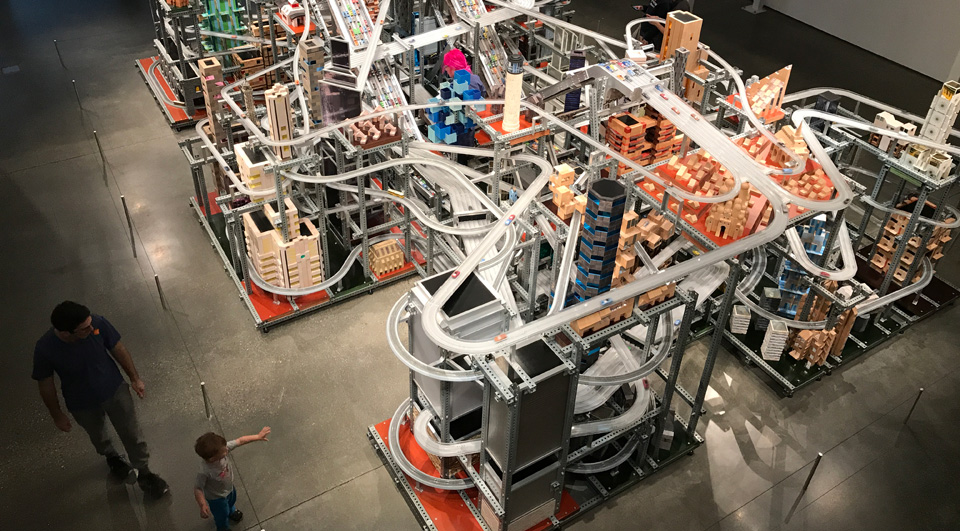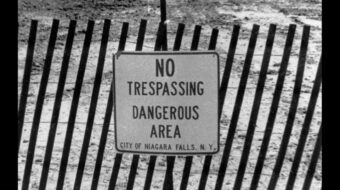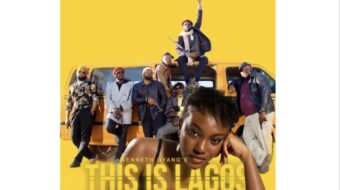
As a young man in his 20s and 30s, Chris Burden (1946-2015) must indeed have seemed like a burden to his friends, teachers and fellow students in the graduate art program at UC Irvine. He was given to copious consumption of mind-bending substances in the 1970s, and to many what appeared to be self-aggrandizing stunts involving a kind of masochistic deprivation, confinement, danger and violence. These were his art “pieces.”
A few examples: He had a friend shoot him in the arm with a rifle, he stuffed himself into a 2-foot cube student locker for five days, he had nails driven through his hands crucifying him to the back of a Volkswagen bug in a garage, and he had himself bolted to the floor by the neck and limbs. Art like this could not be bought and sold, and flew directly into the face of the hyper-inflated art market.
He attached no explanations or defense, leaving it to viewers to react as they saw fit. They could dismiss him outright as a fraud and an insult to the very word “art,” or they could interpret his work according to the emotions it brought up for them or as comments on the human condition. In a relatively short time for a burgeoning experimenter trying to redefine the meaning of being an artist, he started getting noticed by national publications—Esquire magazine among them—as one of America’s most interesting innovators. Film critic Roger Ebert, writing in the Chicago Sun-Times, felt mystified by Burden’s project, but gave him respectful coverage.
Gradually, with commissioned work coming to him more regularly, Burden was able to fabricate ever larger pieces involving motors and mechanical features. He took an enormous flywheel, a heavy disk some eight feet in circumference, mounted it on a stand and kept it speeding around powered by a motorcycle. Was this “art for art’s sake” or a prescient observation about a world hurtling perilously out of control?
As someone who set out to expand the boundaries of art, Burden put himself in a league with Leonardo da Vinci, Michelangelo, and Picasso. Though clearly the pretentious conceit of a young man on the make, such a claim can be seriously debated now that he has become one of the most admired of contemporary artists. Two outstanding works of his grace the Los Angeles County Museum of Art (LACMA): Outside, his Urban Light (2008), which amasses 202 old L.A. lampposts of various heights and designs in front of the museum, aligned in straight rows like soldiers in parade formation, their illumined helmets heralding the dusk and shining brightly all through the night as if to protect the precious cultural treasures inside. It has become, perhaps more than any other object, the artistic symbol of the city. Any time of day, people of all ages can be seen meandering through the columns and posing for photos, most of them probably never knowing who created this old-new modern wonder.
Inside, on long-term loan in the Broad Contemporary Art Museum at LACMA, his Metropolis II (2010) is a complex, room-sized kinetic sculpture summoning up the dystopia of a fast-moving modern city. Anyone negotiating the freeway system in and around L.A. can relate to this elaborate Rube Goldberg-like armature chock-a-block with countless roadways, train tracks, hundreds of high-rise buildings, and 1100 miniature toy cars speeding through space. The installation sits in a room not fifty feet from the cars outside on Wilshire Boulevard, which ironically is now discombobulated by the construction of a new Metro line intended to reduce traffic and congestion. When operational (times vary), Metropolis II can hold a viewer’s fascinated gaze for a very long time. It’s a destination point for children, who can, just a few steps away, also view the La Brea Tar Pits, where prehistoric mastodons have been trapped into eternity.
These two works alone give Chris Burden’s name the kind of immortality he sought as a young man. But only in maturity, with his own spacious work studios and lands in rustic Topanga Canyon nearby to the city of Los Angeles, did he command the resources and personnel to undertake such massive achievements which required collective effort to be realized.
As a self-absorbed start-up artist, Burden documented his performance pieces for his expanding résumé. The new documentary Burden contains many excerpts from the film record of his endurance art, body art and performance art, and from interviews conducted at various stages of his career, from his 20s through his 60s. He appears drugged-out in many of these clips, but nevertheless displays a charming, and disarming sense of his place in the trajectory of art: Salon artists obedient to the establishment rarely make art history books. It’s the rebels and rule-breakers who carve out new territory, opening our eyes with their new visions.
Burden also features interviews with his ex-wife and former lovers, students who knew him at art school, others who worked with him on given pieces, professors who didn’t know what to make of him, and a few severe critics who are there primarily for their hilarity value.
For those who would question the artistic validity of a project such as Shoot (1971), the one where he is filmed getting shot, it’s significant to remember that the Vietnam War was raging at the time. Quite literally, every single day of that year, hundreds of people—Vietnamese, Cambodians, Laotians, Americans and soldiers from American coalition nations—were being shot or bombed or napalmed or torched. Not to mention the gun violence that killed dozens of people every day in the U.S. and the shoot-’em-ups that still obsessively populate almost every TV, film and video screen. How removed from reality can a critic get not to make some connection to Burden’s thought process?
One could even say that, like protesters who chained themselves to the gates of armaments manufacturing plants, or went to jail for civil disobedience, or immolated themselves out of rage against the disgrace of war, Burden assumed the personal burden of moral witness, a measure of control over forces which threatened to yank civilization itself from its moorings. After he had worked through his personal and societal demons, he achieved enough equilibrium, respectability and voice to enable him to produce the more lasting work for which he is known today. Along the way he became one of those who put Los Angeles on the artistic map.
His last major project was the Ode to Santos Dumont (2015), which unveiled at LACMA in May 2015. It’s a monumental sculpture, a floating motorized balloon paying homage to the Brazilian pioneer aviator Alberto Santos-Dumont, widely considered in Europe and Latin America as the father of aviation. Commandeering his petrol engine–powered dirigible around the Eiffel Tower in 1901 to international acclaim, Santos-Dumont proved the viability of human air travel, although in the North American narrative his name has been almost completely obliterated by the Wright Brothers’ experiments in North Carolina two years later. Burden’s hypnotically buoyant contraption can be seen as a recognition of ingenuity and innovation in a world of naysayers, honoring experimentation and failure and and the revelation of new points of view.
The film is sometimes as prickly and difficult as its subject, especially when it treats Burden’s early years. You may squirm a bit at its aggressive approach to the human body, which was the locus of Burden’s work in that period. But it’s an emotionally rich and compelling documentary that recalls an important anti-commercial movement in art and points to far more satisfying outcomes.
Burden opens in New York May 5, and in Los Angeles May 12. Information about a free screening of Burden at LACMA on May 4 can be found here.
Burden
A film by Timothy Marrinan and Richard Dewey
Magnolia Pictures
90 minutes












Comments